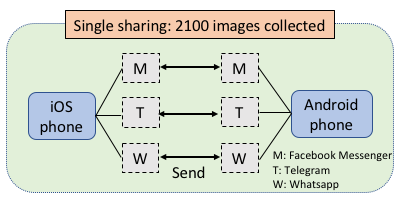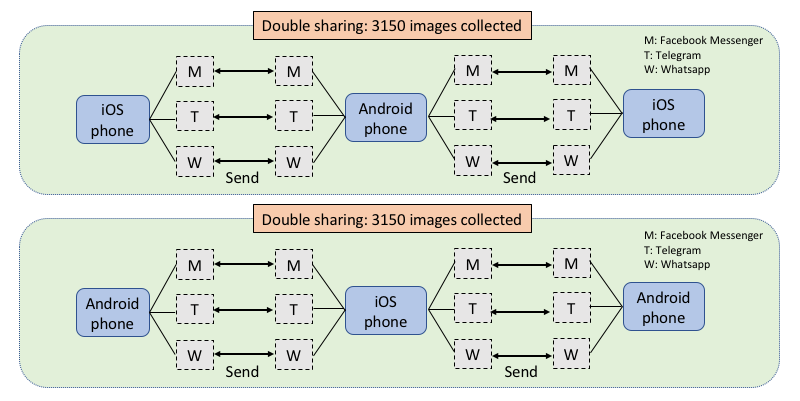| |
The ISIMA (Images Sharing via Instant Messaging App) dataset contains images that are shared between Android phone and iOS phone via three instant messaging applications Facebook Messenger, Whatsapp, and Telegram. All images are stored in JPEG format, following the folder structure as below:
- original-jpeg: the folder containing original-jpeg.txt file indicating original images we extracted from VISION dataset [1].
- single-shared: the folder containing 2100 JPEG images that are shared using three apps {Facebook Messenger, Whatsapp, Telegram} using an Android and an iOS device. For instance, single-shared/Messenger/android-ios contains images shared from Android to iOS via Facebook Messenger. This sharing scenario is depicted in Figure 1.
- double-shared: the folder containing 6300 JPEG images that are shared a second time. For instance, double-shared/Messenger-Telegram/android-ios contains images shared the first time by Facebook Messenger from iOS to Android, and shared the second time by Telegram from Android to iOS. The chain of Operating Systems (OS) in the path of the second sharing (android-ios) also tells us the OS chain of the first sharing which is always the opposite, i.e., ios-android. This sharing scenario is depicted in Figure 2.
Figure 1. Single sharing scenario.
Figure 2. Double sharing scenario.
The dataset can be downloaded in .zip file from: ISIMA
|
| |
|
|
|
| If you use the dataset, please cite our work as:
@inproceedings{Phan2018,
title={Identifying image provenance: an analysis of mobile instant messaging apps},
author={{Q.-T. Phan, C. Pasquini, G. Boato, F. G. B. De Natale}},
booktitle={IEEE 20th International Workshop on Multimedia Signal Processing},
year={2018}
}
|
| |
|
|
|
| References
[1] Dasara Shullani, Marco Fontani, Massimo Iuliani, Omar Al Shaya, Alessandro Piva, "VISION: a video and image dataset for source identification", EURASIP Journal on Information Security, Dec. 2017.
|
| |
|
|
|
| |
|
|
|
| All rights reserved. Multimedia Signal processing and Understanding Lab. - University of Trento |



